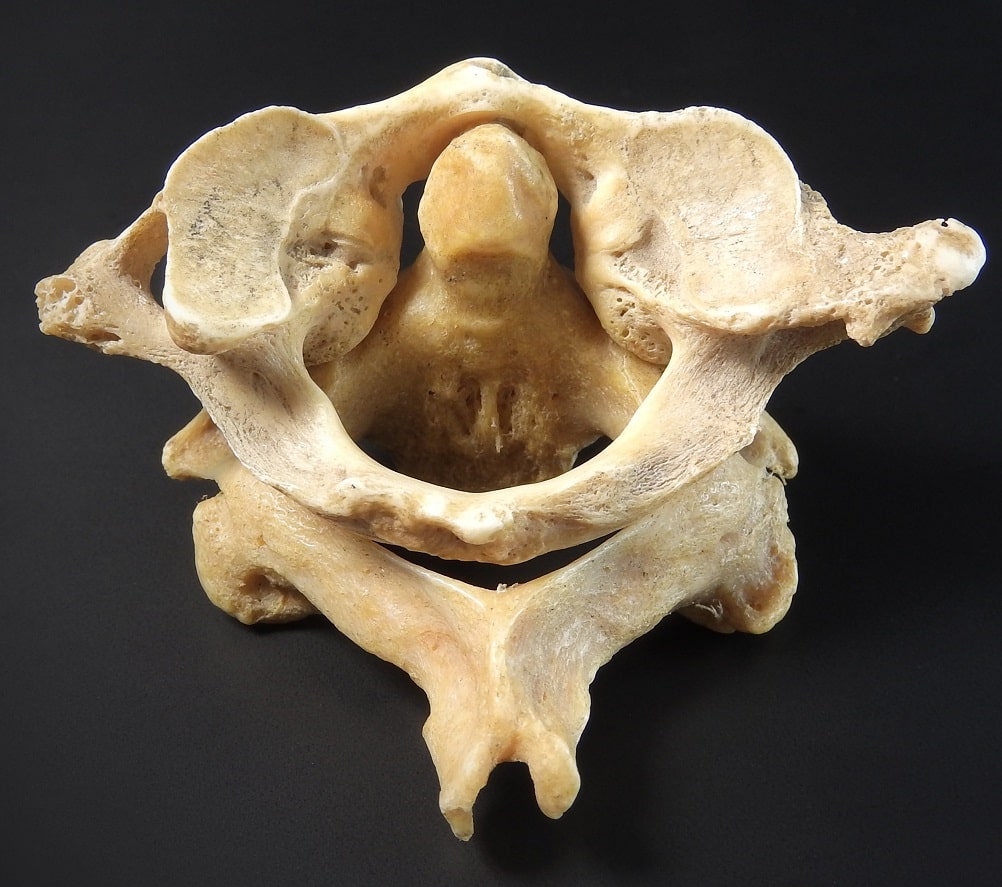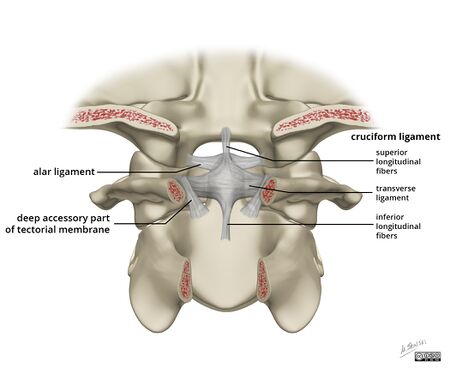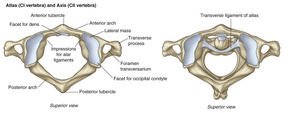Atlanto-axial Joint: Difference between revisions
No edit summary |
No edit summary |
||
| (7 intermediate revisions by the same user not shown) | |||
| Line 1: | Line 1: | ||
{{ | {{Joint | ||
|quality=Stub | |||
|image= | |image=Atlantoaxial joint.jpg | ||
|caption= | |caption=Superior view of the atlantoaxial joint | ||
| | |type=Synovial Joint | ||
|secondary-type=Pivot Joint | |||
|type= | |||
|bones=C1 (Atlas), C2 (Axis) | |bones=C1 (Atlas), C2 (Axis) | ||
|innervation=C2 | |innervation=C2 | ||
|rom=Rotation ~45° each way, flexion-extension ~10° each way, and lateral flexion ~5° each way | |||
|rom=Rotation ~45° each way, flexion-extension ~ | |||
10° each way, and lateral flexion ~5° each way | |||
}} | }} | ||
The atlas (C1) sits on the axis (C2) and the wear is borne through the lateral antlanto-axial joints. Apart from its weight-bearing function, it also allows a large range of axial rotation. | The atlas (C1) sits on the axis (C2) and the wear is borne through the lateral antlanto-axial joints. Apart from its weight-bearing function, it also allows a large range of axial rotation. | ||
== Structure == | == Overview == | ||
{{Cervical spine anatomy and biomechanics}} | |||
==Structure== | |||
[[File:Atlas-axis.png|left|thumb|Atlas and atlanto-axial joint superior view]] | |||
There are three atlanto-axial joints, one median, and two lateral. | There are three atlanto-axial joints, one median, and two lateral. | ||
* The median joint is between the posterior surface of the anterior arch of the atlas (C1) and the front of the odontoid process | *The median joint is between the posterior surface of the anterior arch of the atlas (C1) and the front of the odontoid process | ||
* The lateral atlantoaxial joints are between the lateral mass of the atlas (C1) and axis (C2) on both sides. | *The lateral atlantoaxial joints are between the lateral mass of the atlas (C1) and axis (C2) on both sides. | ||
The articular surface of both the lateral atlantial and axial facets are convex, hence the joint is biconvex. The spaces in the anterior and posterior aspects are filled with intra-articular meniscoids. | The articular surface of both the lateral atlantial and axial facets are convex, hence the joint is biconvex. The spaces in the anterior and posterior aspects are filled with intra-articular meniscoids. | ||
== Movement == | ==Movement== | ||
The atlanto-axial joint provides axial rotation estimated to be 43 ± 5.5°. This is about 50% of the total range of axial rotation of the head and neck. | The atlanto-axial joint provides axial rotation estimated to be 43 ± 5.5°. This is about 50% of the total range of axial rotation of the head and neck. | ||
| Line 38: | Line 33: | ||
Muscles of the atlas (C1): | Muscles of the atlas (C1): | ||
* Levator scapulae: this inserts on the transverse process of the atlas (C1), but this acts on the scapula not the atlas (C1). | *Levator scapulae: this inserts on the transverse process of the atlas (C1), but this acts on the scapula not the atlas (C1). | ||
* Obliquus superior and rectus capitis posterior minor: acts on the occiput | *Obliquus superior and rectus capitis posterior minor: acts on the occiput | ||
* Rectus anterior and rectus lateralis: acts on the occiput | *Rectus anterior and rectus lateralis: acts on the occiput | ||
* Longus cervicis (longus colli): attaches to the anterior tubercle of the atlas (C1) and is a weak flexor of the head. There is no antagonist muscle. | *Longus cervicis (longus colli): attaches to the anterior tubercle of the atlas (C1) and is a weak flexor of the head. There is no antagonist muscle. | ||
The atlas (C1) is essentially a passive washer between the head and rest of the cervical spine. The movements are essentially passive. The principal movements are directed by the muscles that act on the head. For rotation of the atlas (C1), it is splenius capitis and sternocleidomastoid acting on the head that cause this movement. | The atlas (C1) is essentially a passive washer between the head and rest of the cervical spine. The movements are essentially passive. The principal movements are directed by the muscles that act on the head. For rotation of the atlas (C1), it is splenius capitis and sternocleidomastoid acting on the head that cause this movement. | ||
| Line 47: | Line 42: | ||
With this passive motion, the atlas (C1) can often extend during full cervical flexion depending on whether the compression load is directed anterior or posterior to the atlanto-axial joint contact point. | With this passive motion, the atlas (C1) can often extend during full cervical flexion depending on whether the compression load is directed anterior or posterior to the atlanto-axial joint contact point. | ||
== Stability and Restraints == | ==Stability and Restraints== | ||
[[File:Alar-and-cruciform-ligament-anatomy.jpg|thumb|'''The suboccipital joints and ligaments''' from behind, with the posterior arch of the atlas (C1) resected. The lateral mass of the atlas (C1) supports the occipital bone and sits on the axis (C2), forming the atlanto-occipital joint above and the lateral atlantoaxial joint below. The alar ligament holds the odontoid process of the axis (C2) to the foramen magnum bypassing the atlas (C1). The transverse ligament holds the atlas (C1) (C1) against the odontoid process.|450x450px]] | [[File:Alar-and-cruciform-ligament-anatomy.jpg|thumb|'''The suboccipital joints and ligaments''' from behind, with the posterior arch of the atlas (C1) resected. The lateral mass of the atlas (C1) supports the occipital bone and sits on the axis (C2), forming the atlanto-occipital joint above and the lateral atlantoaxial joint below. The alar ligament holds the odontoid process of the axis (C2) to the foramen magnum bypassing the atlas (C1). The transverse ligament holds the atlas (C1) (C1) against the odontoid process.|450x450px]] | ||
There are no true ligaments providing restraint to flexion and extension. There are fascial membranes that don't provide any significant ligamentous restraint. The atlas (C1) can flex until the posterior arch hits the occiput, or extend until it hits the neural arch of C2. | There are no true ligaments providing restraint to flexion and extension. There are fascial membranes that don't provide any significant ligamentous restraint. The atlas (C1) can flex until the posterior arch hits the occiput, or extend until it hits the neural arch of C2. | ||
| Line 62: | Line 57: | ||
The C2 spinal nerve is located behind the lateral atlantoaxial joint. The dorsal ramus supplies the superficial posterior neck muscles, and becomes the greater occipital nerve running over the occiput. The ventral ramus innervates the lateral atlantoaxial joint and then joins the cervical plexus. | The C2 spinal nerve is located behind the lateral atlantoaxial joint. The dorsal ramus supplies the superficial posterior neck muscles, and becomes the greater occipital nerve running over the occiput. The ventral ramus innervates the lateral atlantoaxial joint and then joins the cervical plexus. | ||
== See Also == | ==See Also== | ||
* [[Atlanto-occipital Joint]] | *[[Atlanto-occipital Joint]] | ||
* [[Cervical Spine Biomechanics]] | *[[Cervical Spine Biomechanics]] | ||
* [[Cervical Vertebrae]] | *[[Cervical Vertebrae]] | ||
== References == | ==References== | ||
* Bogduk et al. Biomechanics of the cervical spine. I: Normal kinematics. Clinical Biomechanics. 2000 | *Bogduk et al. Biomechanics of the cervical spine. I: Normal kinematics. Clinical Biomechanics. 2000 | ||
[[Category:Cervical Spine Anatomy]] | [[Category:Cervical Spine Anatomy]] | ||
[[Category:Joints]] | [[Category:Joints]] | ||
[[Category:Joints of the Spine]] | |||
Latest revision as of 08:48, 12 June 2022

| |
| Atlanto-axial Joint | |
|---|---|
| Primary Type | Synovial Joint |
| Secondary Type | Pivot Joint |
| Bones | C1 (Atlas), C2 (Axis) |
| Ligaments | |
| Muscles | |
| Innervation | C2 |
| Vasculature | |
| ROM | Rotation ~45° each way, flexion-extension ~10° each way, and lateral flexion ~5° each way |
| Volume | |
| Conditions | |
The atlas (C1) sits on the axis (C2) and the wear is borne through the lateral antlanto-axial joints. Apart from its weight-bearing function, it also allows a large range of axial rotation.
Overview
| C0-1 | C1-2 | C2-7 | |
|---|---|---|---|
| Anatomy | 1. Superior facets of C0 (Atlas): 28° in sagittal and transverse planes
2. No disc |
1. C1 has convex facet joint surface (allow C1 facet to slide in AP direction over C2)
2. No disc 3. Transverse lig : prevent dense posterior dislocation 4. Alar lig: limiting rotation |
Anatomy structure grossly similar.
1. 2x uncovertebral joints (joints of Luschka) at each segments. They are not true synovial joints (clefts at the lateral edges of IVD between uncinated process inferiorly, and the edge of the vertebral body above) 2. 1 disc between each vertebra body. 3. 2 facet joints: at 45° inclination to horizontal plan (pure rotation, side bending is limited) |
| Biomechanics |
|
Rotation: 45° both directions.
(Rotation in full flexion is C1-2 rotation) |
|
Structure
There are three atlanto-axial joints, one median, and two lateral.
- The median joint is between the posterior surface of the anterior arch of the atlas (C1) and the front of the odontoid process
- The lateral atlantoaxial joints are between the lateral mass of the atlas (C1) and axis (C2) on both sides.
The articular surface of both the lateral atlantial and axial facets are convex, hence the joint is biconvex. The spaces in the anterior and posterior aspects are filled with intra-articular meniscoids.
Movement
The atlanto-axial joint provides axial rotation estimated to be 43 ± 5.5°. This is about 50% of the total range of axial rotation of the head and neck.
During rotation the anterior arch of the atlas (C1) pivots around the odontoid process (i.e. the median atlantoaxial joint), while the lateral masses slide backwards or forwards, circumferentially (i.e. at the lateral atlantoaxial joints).
At neutral, the biconvex joint peaks approximate each other. With atlas (C1) rotation the ipsilateral facet slides down the posterior slope of its axial facet, while the contralateral facet slides down the anterior slope of its axial facet. The results in the atlas (C1) descending into the axis (C2). With rotation back to neutral the atlas (C1) rises back up.
Flexion-extension is only about 10° (each way), and lateral flexion about 5° (each way).
Muscles of the atlas (C1):
- Levator scapulae: this inserts on the transverse process of the atlas (C1), but this acts on the scapula not the atlas (C1).
- Obliquus superior and rectus capitis posterior minor: acts on the occiput
- Rectus anterior and rectus lateralis: acts on the occiput
- Longus cervicis (longus colli): attaches to the anterior tubercle of the atlas (C1) and is a weak flexor of the head. There is no antagonist muscle.
The atlas (C1) is essentially a passive washer between the head and rest of the cervical spine. The movements are essentially passive. The principal movements are directed by the muscles that act on the head. For rotation of the atlas (C1), it is splenius capitis and sternocleidomastoid acting on the head that cause this movement.
With this passive motion, the atlas (C1) can often extend during full cervical flexion depending on whether the compression load is directed anterior or posterior to the atlanto-axial joint contact point.
Stability and Restraints

There are no true ligaments providing restraint to flexion and extension. There are fascial membranes that don't provide any significant ligamentous restraint. The atlas (C1) can flex until the posterior arch hits the occiput, or extend until it hits the neural arch of C2.
For axial rotation, the capsules of the lateral atlanto-axial joints and the alar ligaments provide some restraints. The capsules are loose and provide only minor restraint. The alar ligaments are the cardinal restraints to axial rotation and dislocation in rotation doesn't occur while this is intact. The alar ligaments run from the upper end of the odontoid process to the margin of the foramen magnum, bypassing the atlas (C1). They effectively lock the axis (C2) into the head and in doing so clamp the atlas (C1) between the skull and the axis (C2).
Disruption of an alar ligament can lead to rotatory instability. With excessive axial rotation, the lateral mass of the atlas (C1) can dislocate at the lateral atlantoaxial joint, leading to a fixed atlantoaxial deformity.
For sliding, backward sliding has a bony limitation with impaction of the anterior arch of the atlas (C1) against the odontoid process. There is no bony restraint to forward sliding. Forward sliding is limited by the transverse ligament of the atlas (C1) and the alar ligaments. Dislocation in sliding doesn't occur if one of these is intact.
For lateral gliding, the primary restraint is the contralateral alar ligament, and bony impact of the lateral mass on the side of the odontoid process.
Innervation
The C2 spinal nerve is located behind the lateral atlantoaxial joint. The dorsal ramus supplies the superficial posterior neck muscles, and becomes the greater occipital nerve running over the occiput. The ventral ramus innervates the lateral atlantoaxial joint and then joins the cervical plexus.
See Also
References
- Bogduk et al. Biomechanics of the cervical spine. I: Normal kinematics. Clinical Biomechanics. 2000


